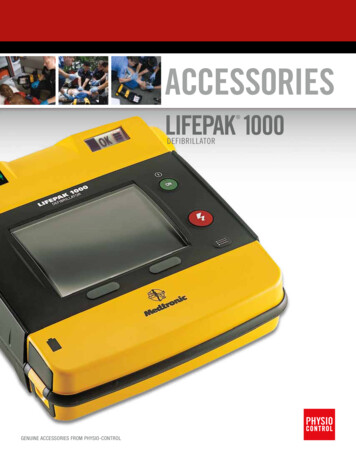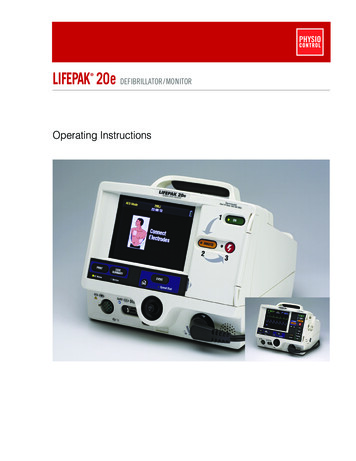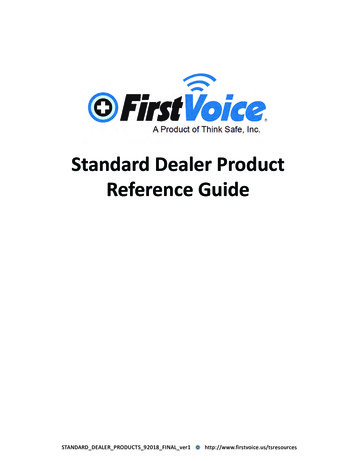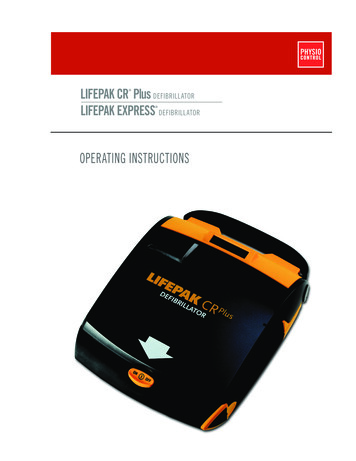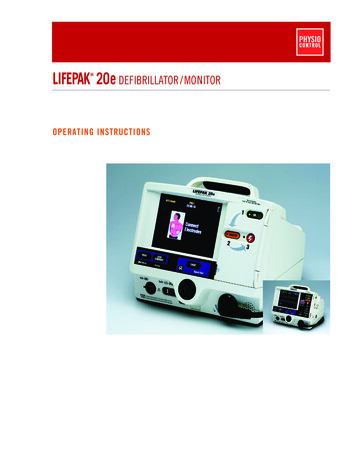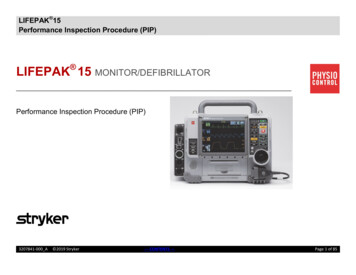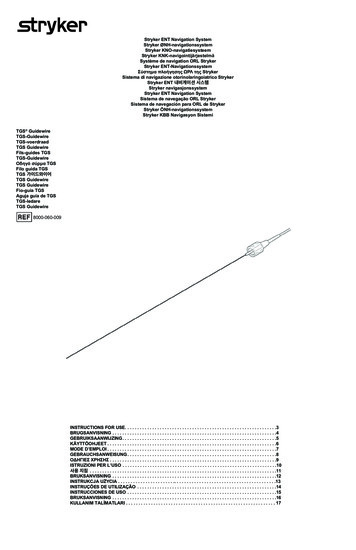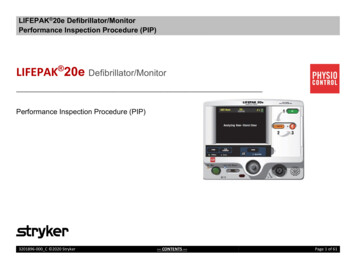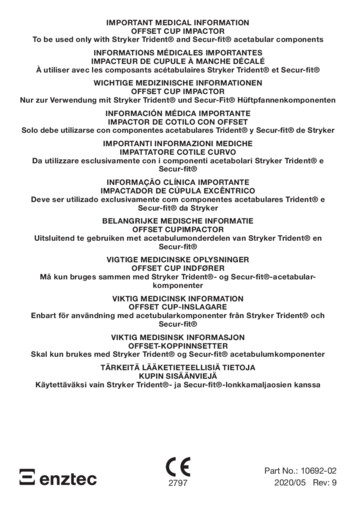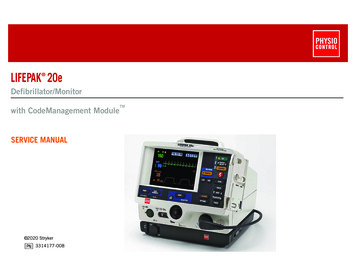
Transcription
LIFEPAK 20eDefibrillator/Monitorwith CodeManagement ModuleSERVICE MANUAL 2020 Stryker3314177-008TM
LIFEPAK 20e Defibrillator/MonitorTable of ContentsClick a TopicPrefaceSafetyDeviceDescriptionModes acementProceduresCodeManagementModuleLIFEPAK 20eSpecificationsTitle PageBackIndexNext Page
LIFEPAK 20e Defibrillator/MonitorPrefaceSection ContentsThis service manual describes how to maintain, test, troubleshoot, and repair theLIFEPAK 20e defibrillator/monitor (device).Note: Except where specified, the information in this manual pertains to theLIFEPAK 20e defibrillator/monitor with CodeManagement Module. TheCodeManagement Module may not be available in all countries.Separate publications, the LIFEPAK 20e Defibrillator/Monitor OperatingInstructions, are used by physicians, clinicians, and emergency care providers.The operating instructions provide step-by-step instructions, as well as operatorlevel testing and maintenance.Note: Hyperlinks appear in blue text. Text that indicates the name of a button,menu, menu item, screen message, or screen overlay appears in allcaps (for example, ANALYZE button and SETUP menu).This section covers the following topics:TrademarksUsing Adobe Acrobat ReaderNavigating Through the Manual(Continued on next page)Previous PageTable of ContentsBackIndexNext Page
LIFEPAK 20e Defibrillator/MonitorPreface (continued)Section ContentsContacting Physio-ControlResponsibility for InformationDevice TrackingService InformationWarranty InformationConfiguration InformationGlossaryAcronymsPrevious PageTable of ContentsBackIndexNext Page
LIFEPAK 20e Defibrillator/MonitorPrefaceTrademarks1-4Stryker or its affiliates own, use, or have applied for the following trademarks orservice marks: LIFEPAK, FAST-PATCH, QUIK-COMBO, CodeManagementModule, CODE SUMMARY, REDI-PAK, and Shock Advisory System. All othertrademarks are trademarks of their respective owners or holders.The absence of a product, feature, or service name, or logo from this list doesnot constitute a waiver of Stryker’s trademark or other intellectual property rightsconcerning that name or logo. 2020 StrykerPN 3314177-008Publication date: 01/2021Previous PageTable of ContentsSection ContentsBackIndexNext Page
LIFEPAK 20e Defibrillator/MonitorPrefaceUsing Adobe Acrobat Reader1-5Accessing AdobeReader HelpThis service manual opens in Adobe Acrobat Reader. The Adobe Reader canbe downloaded for free at the Adobe internet URL http://www.adobe.com/products/reader.html. For additional assistance using the Adobe Readerprogram, access ACROBAT READER HELP in the HELP menu.Using BookmarksBookmarks appear in a column on the left side of the screen. They enable you toeasily navigate to main sections of the manual, similar to a table of contents.To view or hide the bookmarks column, click the BOOKMARKS tab located to thefar left of the screen.To jump to a bookmark topic, click the desired topic.Note: A plus sign to the left of a bookmark topic indicates additional topics existunder that bookmark level. Click the plus sign to expand or collapse thebookmarks.Using Page ViewPrevious PageClick the PAGES tab located to the far left of the screen to view miniature imagesof each page in the document. Scroll through the pages and click an image tojump quickly to that page.Table of ContentsSection ContentsBackIndexNext Page
LIFEPAK 20e Defibrillator/MonitorPrefaceNavigating Through the Manual1-6BackBlue text indicates a hyperlink. Click a link to jump to that topic. Clickin the navigation bar at the bottom of each page to return to your previouslocation. The pointer changes to a pointing fingerwhen positioned over a link.A navigation bar at the bottom of each page also provides helpful links. Thenavigation bar includes:Table of Contents Click to jump to the main table of contents for the manual. Section Contents Click to jump to the table of contents for the sectionyou are currently viewing. Index Back Click to retrace your steps in a document, returning to each pagein the reverse order visited. Next Page Click to jump to the index.Click to jump to the next page of the manual.Previous Page Click to jump to the previous page of the manual.Some pages include an additional navigation bar above the main bar thatprovides access to closely related topics.Previous PageTable of ContentsSection ContentsBackIndexNext Page
LIFEPAK 20e Defibrillator/MonitorPrefaceContacting Physio-Control1-7StrykerEmergency Care11811 Willows Road NEP.O. Box 97006Redmond, WA 98052 USATel: 425 867 4000Toll Free (USA only): 800 442 1142Fax: 425 458 1404strykeremergencycare.comStryker European Operations LimitedAnngrove, IDA Business & Technology ParkCarrigtwohill, Co. Cork, T45 HX08 IrelandStryker Australia Pty Ltd8 Herbert StreetSt LeonardsNSW 2065AustraliaPrevious PageTable of ContentsSection ContentsBackIndexNext Page
LIFEPAK 20e Defibrillator/MonitorPrefaceResponsibility for Information1-8This service manual describes the methods required to maintain, test, and repairthe device. It does not address the operation of the device. Qualified servicepersonnel must consult the appropriate operating instructions and this servicemanual to obtain a complete understanding of the use and maintenance of thedevice.It is the responsibility of our customers to ensure that the appropriate person(s)within their organization has access to the information in this service manual,including any warnings and cautions used throughout the manual.Previous PageTable of ContentsSection ContentsBackIndexNext Page
LIFEPAK 20e Defibrillator/MonitorPrefaceDevice Tracking1-9!USA Device Tracking:The U.S. Food and Drug Administration requires defibrillator manufacturers anddistributors to track the location of their devices. If the device is locatedsomewhere other than the shipping address or if your device has been sold,donated, lost, stolen, exported, or destroyed, or if it was not obtained directlyfrom Physio-Control, please notify the device-tracking coordinator at1.800.426.4448. Refer to your operating instructions for more informationconcerning device tracking.Previous PageTable of ContentsSection ContentsBackIndexNext Page
LIFEPAK 20e Defibrillator/MonitorPrefaceService Information1-10Before attempting to clean or repair any assembly in the device, the servicetechnician should be familiar with the information provided in the PreventiveMaintenance section of this manual.A qualified service technician should inspect any device that has been dropped,damaged, or abused to verify that the device is operating within performancestandards listed in the Performance Inspection Procedure (PIP), and that theleakage current values are acceptable.Replacement procedures for the device are limited to those items accessible atthe subassembly level. Replacements and adjustments must be made byqualified service personnel. Replacements at the subassembly level simplifyrepair and servicing procedures and help ensure correct device operation andcalibration. Printed circuit board assemblies that require software may requireinstallation by a Physio-Control Service representative.Also see CodeManagement Module section of this manual for additionalreplacement and test procedures.To obtain Physio-Control service and maintenance for your device, contact yourlocal service or sales representative. In the USA, call Physio-Control TechnicalSupport at 1.800.442.1142. Outside the USA, contact your local Physio-Controlrepresentative. When you call Physio-Control to request service, provide thefollowing information:Previous PageTable of ContentsSection ContentsBackIndexNext Page
LIFEPAK 20e Defibrillator/MonitorPrefaceService Information (continued)1-11 Model number and part number Serial number Observation of the problem that led to the callPrevious PageTable of ContentsSection ContentsBackIndexNext Page
LIFEPAK 20e Defibrillator/MonitorPrefaceWarranty Information1-12To obtain a detailed warranty statement, contact your local Strykerrepresentative or go to strykeremergencycare.com.Previous PageTable of ContentsSection ContentsBackIndexNext Page
LIFEPAK 20e Defibrillator/MonitorPrefaceBattery Recycling Information1-13Recycle the device at the end of its useful life. Previous PageRecycling assistance – The device should be recycled according to nationaland local regulations. For instructions on disposing of this product or itsaccessories, see strykeremergencycare.com/recyclingPreparation – The device should be clean and contaminant-free prior tobeing recycled.Recycling of disposable electrodes – After using disposable electrodes,follow your local clinical procedures for recycling.Recycling of batteries – The device uses rechargeable Lithium-ion batteries.Follow local guidelines and instructions provided in this service manual fordiscarding and recycling batteries as described.Packaging – packaging should be recycled according to national and localregulations.Table of ContentsSection ContentsBackIndexNext Page
LIFEPAK 20e Defibrillator/MonitorPrefaceConfiguration Information1-14This service manual covers existing devices and options through the followingrevisions:Previous Page LIFEPAK 20e defibrillator/monitor basic device with ECG Pacing option SpO2 option CodeManagement Module for wireless LIFENET System connection CodeManagement Module with EtCO2 optionTable of ContentsSection ContentsBackIndexNext Page
LIFEPAK 20e Defibrillator/MonitorPrefaceGlossary1-15The following are definitions of terms used throughout this service manual. Automated external defibrillator (AED) — The device uses an ECG analysisShock Advisory System to advise the device operator if it detects ashockable or nonshockable rhythm. For more information, refer to the ShockAdvisory System section in the operating instructions. Biphasic technology — The shock waveform generated by the device. Thebiphasic waveform is characterized by a positive current phase, followed bya reverse current phase of shorter duration and decreased magnitude. Thewaveform pulse characteristic is biphasic truncated exponential (BTE). CODE SUMMARY report — A summary report that consists of apreamble, an event/vital signs log, and waveforms associated with certainevents. Refer to the Data Management section in the operating instructionsfor a sample CODE SUMMARY report.(Continued on next page)Previous PageTable of ContentsSection ContentsBackIndexNext Page
LIFEPAK 20e Defibrillator/MonitorPrefaceGlossary (continued)1-16 Continuous patient surveillance system (CPSS) — A feature that monitorsthe patient ECG in LEADS or PADDLES for a potentially shockable rhythm.CPSS is active when the AED MODE indicator is on or the VF/VT ALARM isselected after pressing the ALARMS button (manual mode). The CPSSoperates in conjunction with the Shock Advisory System. For moreinformation, refer to the Shock Advisory System section in the operatinginstructions. EtCO2 — A capnograph device that uses non-dispersive infraredspectroscopy to continuously measure the amount of CO2 during eachbreath and report the amount present at the end of exhalation. FAST-PATCH disposable defibrillation/ECG electrodes — An electrodesystem that allows delivery of defibrillation therapy to the patient. QUIK-COMBO pacing/defibrillation/ECG electrodes — An electrode systemthat allows delivery of pacing and defibrillation therapy to the patient. QUIK-COMBO patient simulator — A combination lead tester/patientcardiac rhythm simulator. The simulator is designed for use in trainingclinical personnel in the operation of the device.(Continued on next page)Previous PageTable of ContentsSection ContentsBackIndexNext Page
LIFEPAK 20e Defibrillator/MonitorPrefaceGlossary (continued)Previous Page1-17 REDI-PAK preconnect system — A variant of the QUIK-COMBO pacing/defibrillation/ECG electrodes system. The system allows QUIK-COMBOpacing/defibrillation/ECG electrode cable connection without removing theelectrodes from their air-tight sealed pouch until needed. Shock Advisory System — A computerized ECG analysis system used todetect a shockable rhythm. For more information, refer to the ShockAdvisory System section in the operating instructions. SpO2 — A noninvasive pulse oximeter that checks the saturation of oxygenin arterial blood. Test plug — An accessory used to connect the test load to the patientconnector on the device. LIFENET Asset, LIFENET Device Agent — Software application that allowsthe user to change device user configuration and software updates.LIFENET Device Agent also provides a servicing tool to check and calibratethe CO2 module which is part of the CodeManagement Module. For moreinformation about LIFENET System refer to internet:strykeremergencycare.comTable of ContentsSection ContentsBackIndexNext Page
LIFEPAK 20e Defibrillator/MonitorPrefaceAcronyms1-18The following is a list of acronyms and abbreviations used in this FCPRCPUCPSSDMMDSPAssociation for the Advancement of Medical InstrumentationAnalog-to-digital conversionAutomated external defibrillatorAmpere hourAmerican Heart AssociationAmerican National Standards InstituteBiphasic truncated exponentialElectrically isolated, external body connectionBeats per minuteElectrically isolated, direct cardiac connectionCardiopulmonary resuscitationCentral processing unitContinuous patient surveillance systemDigital multimeterDigital signal processor(Continued on next page)Previous PageTable of ContentsSection ContentsBackIndexNext Page
LIFEPAK 20e Defibrillator/MonitorPrefaceAcronyms l universal asynchronous receiver/transmitterElectrocardiogramEmergency medical serviceElectrostatic dischargeElectrosurgical unitEnd-tidal carbon dioxideInspired carbon dioxideHeart rateInternational Electrical CommissionLiquid crystal displayLight-emitting diodeMillimeters of mercuryNational Heart Attack Alert ProgramNormal sinus rhythmOriginal equipment manufacturerPersonal computerPrinted circuit board(Continued on next page)Previous PageTable of ContentsSection ContentsBackIndexNext Page
LIFEPAK 20e Defibrillator/MonitorPrefaceAcronyms (continued)1-20TermDescriptionPIPPerformance inspection procedurePPMPulses per minuteRISCReduced instruction set computerRRRespiration rateRTC/NVRAM Real-time clock/non-volatile random-access memoryPrevious PageSSDStatic-sensitive deviceTCPTest and calibration procedureVACVolts, Alternating CurrentVFVentricular fibrillationVTVentricular tachycardiaTable of ContentsSection ContentsBackIndexNext Page
LIFEPAK 20e Defibrillator/MonitorSafetySection ContentsThis section describes the general safety conventions, terms, and symbols usedin this service manual or on the device. This information is intended to alertservice personnel to recommended precautions in the care, use, and handling ofthis medical device.22TermsGeneral Warnings and CautionsSymbolsPrevious PageTable of ContentsBackIndexNext Page
LIFEPAK 20e Defibrillator/MonitorSafetyTerms2-2The following terms are used in this service manual or on the variousconfigurations of the device. Familiarize yourself with their definitions andsignificance.Danger:Immediate hazards that will result in serious personal injury or death.Warning: Hazards or unsafe practices that could result in serious personalinjury or death.Previous PageCaution:Hazards or unsafe practices that may result in minor personal injury,product damage, or property damage.Note:Points of particular interest for more efficient or convenient deviceoperation; additional information or explanation concerning thesubject under discussion.Table of ContentsSection ContentsBackIndexNext Page
LIFEPAK 20e Defibrillator/MonitorSafetyGeneral Warnings and Cautions2-3The following are general warnings and cautions. Keep these warnings andcautions in mind when working with the device. More specific warnings andcautions appear throughout this service manual and the operating instructions.WARNINGShock hazard. The defibrillator delivers up to 360 J of electrical energy. Unlessproperly used as described in the operating instructions, this electrical energy maycause serious injury or death. Do not attempt to operate or service this device unlessthoroughly familiar with the function of all controls, indicators, connectors, andaccessories.Servicing of this device must be performed by properly trained individuals. Thisdevice may retain potentially lethal charges accessible inside the device at any time –even when off. Follow procedures carefully for discharging the A13 Energy StorageCapacitor.Shock or fire hazard. Do not immerse any portion of this device in water or otherfluids. Avoid spilling any fluids on the device or accessories. If the device is everimmersed in water or other fluids, remove the batteries and disconnect ac power untilthe device can be serviced.Equipment or accessories improperly interconnected to each other can be a sourceof ignition or cause a shock. Make sure that all equipment is interconnected safely(Continued on next page)Previous PageTable of ContentsSection ContentsBackIndexNext Page
LIFEPAK 20e Defibrillator/MonitorSafetyGeneral Warnings and Cautions (continued)2-4WARNINGShock hazard. To avoid the risk of electrical shock, this equipment must only beconnected to a supply mains with protective earth.All equipment connected to the system or ECG/sync connector must be batterypowered or electrically isolated from AC power according to EN 60601-1.Possible fire or explosion hazard. Do not service this device in the presence offlammable gases, anesthetics, or oxygen sources.Patient hazard. Do not mount the device directly above the patient. Place the device ina location where it cannot harm the patient should it fall from its shelf or other mountCAUTIONPossible equipment damage. This device may be damaged by mechanical or physicalabuse such as immersion in water or dropping. If the device has been abused,remove it from use and contact qualified service personnel.Previous PageTable of ContentsSection ContentsBackIndexNext Page
LIFEPAK 20e Defibrillator/MonitorSafetySymbols2-5The following list includes symbols that may be used in this service manual or onvarious configurations of the device and accessories. Some symbols may not berelevant to your device or used in every country.Defibrillation-proof type CF applied partDefibrillation proof, type BF applied partType BF applied partCautionOperating instructionsFollow instructions for useGeneral warning (symbol is black on yellow background)Warning, high voltage(Continued on next page)Previous PageTable of ContentsSection ContentsBackIndexNext Page
LIFEPAK 20e Defibrillator/MonitorSafetySymbols (continued)2-6Equipotential connectorPositive terminalNegative terminalAlternating current voltageDirect current voltageOn (power: connection to the ac mains)Off (power: disconnection from the ac mains)Power on/offSwitch onSwitch offMR unsafe: keep away from magnetic resonance imaging(MRI) equipment(Continued on next page)Previous PageTable of ContentsSection ContentsBackIndexNext Page
LIFEPAK 20e Defibrillator/MonitorSafetySymbols (continued)2-7Safety ground. Protective earth connectionIndoor use only[signal] Input[signal] OutputCO2 InputCO2 ExhaustSync in/ECG outSystem connector/data inHOME SCREEN buttonAlarm offAlarm on(Continued on next page)Previous PageTable of ContentsSection ContentsBackIndexNext Page
LIFEPAK 20e Defibrillator/MonitorSafetySymbols (continued)2-8Biphasic defibrillator shockShock button(x)JShock count (x) on screenJoulesAdult defibrillation paddleInfant defibrillation paddlePace arrow, internal pacingPace arrow, noninvasive pacingR-wave sense markerEvent marker(Continued on next page)Previous PageTable of ContentsSection ContentsBackIndexNext Page
LIFEPAK 20e Defibrillator/MonitorSafetySymbols (continued)2-9Greater thanLess thanVF/VT alarm onVF/VT alarm silencedBattery status indicatorAC power indicator (CodeManagement Module only)FuseDevice includes RF transmitterStatic-sensitive device (SSD)Mark of conformity to applicable European Directives(Continued on next page)Previous PageTable of ContentsSection ContentsBackIndexNext Page
LIFEPAK 20e Defibrillator/MonitorSafetySymbols (continued)2-10Canadian Standards Association certification for Canadaand the United StatesIntertek certification for Canada and the United StatesUnderwriters Laboratories recognized component mark forCanada and the United StatesMark of conformity to ACA standardsLIFEPAK 20e defibrillator/monitor to LIFEPAK 20edefibrillator/monitor cableTurn counterclockwise to unlockManufacturerDate of manufacture shown: YYYY-MM-DDSerial numberAuthorized EC representative(Continued on next page)Previous PageTable of ContentsSection ContentsBackIndexNext Page
LIFEPAK 20e Defibrillator/MonitorSafetySymbols (continued)2-11Reorder numberSee website for patent informationSee website for patent informationQuantityPart numberAssembled in the USARefurbished deviceUsed deviceUse by date shown: yyyy-mm-ddDo not reuseDo not dispose of this product in the unsorted municipalwaste stream. Dispose of this product according to localregulations. See strykeremergencycare.com/recycling forinstructions on the proper disposal of this product.(Continued on next page)Previous PageTable of ContentsSection ContentsBackIndexNext Page
LIFEPAK 20e Defibrillator/MonitorSafetySymbols (continued)2-12Symbol for China RoHS indicating the EnvironmentallyFriendly Use Period (EFUP) denoting the number of yearsbefore any substance is likely to leak out into theenvironment.Recycle this itemProtected from vertically dripping water per IEC 60529!USAFor USA audiences onlyFragile. Handle with care.Federal law restricts this device to sale by or on the orderof a physicianKeep dryRecommended storage temperature 5 to 45 C (41 to113 F). Storage at extreme temperatures of -20 or 60 C (4 or 140 F) is limited to seven days. If storage at thesetemperatures exceeds one week, the electrode shelf-life isreduced.(Continued on next page)Previous PageTable of ContentsSection ContentsBackIndexNext Page
LIFEPAK 20e Defibrillator/MonitorSafetySymbols (continued)2-13Recommended storage temperature range 5 to 45 C(41 to 113 F).Recommended shipping temperature range -20 to 60 C (4 to 140 F).Relative humidity range 5% to 95%.This end upPrevious PageTable of ContentsSection ContentsBackIndexNext Page
LIFEPAK 20e Defibrillator/MonitorDeviceDescriptionSection ContentsThis section describes the physical characteristics and functionality of theLIFEPAK 20e monitor/defibrillator (device). This section includes the nally powered Class 1 device withbattery backup.Ordering Devices, Supplies, and AccessoriesSystem Context DiagramsFunctional DescriptionPrevious PageTable of ContentsBackIndexNext Page
LIFEPAK 20e Defibrillator/MonitorDevice DescriptionIntroduction3-2About the DeviceThe LIFEPAK 20e defibrillator/monitor (device) is a complete, acute, cardiaccare response system with both manual and semiautomatic defibrillationoperation. When clinically indicated, the device enables the operator to deliver abrief, high-energy pulse of electricity to the patient’s heart. Operators canpreconfigure the device to reduce complexity during normal operation.Energy DeliveryThe device generates a biphasic truncated exponential (BTE) shock pulse fordefibrillation. The standard method of energy delivery is through self-adhesiveQUIK-COMBO pacing/defibrillation/ECG electrodes. When using thesedisposable defibrillation electrodes (DDEs), internal circuitry continuouslymeasures the impedance between the electrodes and allows defibrillation onlywhen the defibrillation electrodes are attached to the patient. The user can selectfrom a variety of optional accessories for energy delivery (for example, standardpaddles or internal paddles).Previous PageTable of ContentsSection ContentsBackIndexNext Page
LIFEPAK 20e Defibrillator/MonitorDevice DescriptionIntroduction (continued)3-3Manual ModeOperationIn manual mode (AED MODE indicator off), the device enables the operator tomanually select an energy level, initiate a charge sequence, and apply energy ineither direct or synchronized modes. When the operator selects the VF/VT ALARMfrom the ALARMS menu, the continuous patient surveillance system (CPSS)monitors the patient’s ECG for a shockable rhythm. A suspect rhythm alerts theoperator with a priority tone and screen message. The operator can then followlocally established guidelines for the administration of defibrillation therapy.AED Mode OperationIn AED mode (AED MODE indicator on), the device uses the CPSS to monitor thepatient’s ECG for a shockable rhythm. A suspect rhythm alerts the operator witha priority tone and screen message. The operator may continue by pressing theANALYZE button, which allows the Shock Advisory System to analyze the ECGrhythm and make recommendations. The operator can then follow locallyestablished guidelines for the administration of defibrillation therapy. For moreinformation about CPSS and Shock Advisory System, refer to Appendix E in theoperating instructions.Previous PageTable of ContentsSection ContentsBackIndexNext Page
LIFEPAK 20e Defibrillator/MonitorDevice DescriptionIntroduction (continued)Device PrimaryFunctions3-4The device has four primary functions: Defibrillation– Manual or semi-automatic (AED) defibrillation– Synchronized cardioversion in manual mode– Leads-off detection for therapy and ECG electrodes Noninvasive pacing– Demand and nondemand modes of operation Capture patient information– Stores both patient and device data at each event– Real-time clock provides time stamps for events– Provides operator review of started events for printoutPatient signal monitoring– Displays up to two waveforms at once– Displays a continuous pulse oximetry (SpO2) readout– Displays a continuous End-tidal carbon dioxide (EtCO2) readout– Displays a continuous heart rate readout– Displays waveform pace and sense markers– Monitors for ventricular fibrillation/ventricular tachycardia and sounds awarning alarm– Prints continuous ECG dataService features include calibration and diagnostic functions. Previous PageTable of ContentsSection ContentsBackIndexNext Page
LIFEPAK 20e Defibrillator/MonitorDevice DescriptionIntroduction (continued)Assemblies3-5The device consists of a three-piece case assembly and optional extensionmodule that enclose the following modules/PCBs:1. System Control PCB4. Therapy PCB2. Patient Parameter PCB5. User Interface PCB3. Power module6. OEM modulesand the following OEM and mechanical components:See LP20e InterconnectDiagramPrevious Page1. Display7. Patient connector panel2. Speaker8. System connector panel module3. User controls and indicators9. Internal ac to dc power supply4. Printer10. Internal battery5. SpO2 acquisition11. Internal cables6. EtCO2 module12. Wireless interface to LIFENETand the following attachments:1. ECG 3- or 5-wire cables4. EtCO2 accessories2. QUIK-COMBO cable5. Internal paddles3. SpO2 cable6. Standard paddlesTable of ContentsSection ContentsBackIndexNext Page
LIFEPAK 20e Defibrillator/MonitorDevice DescriptionIntroduction (continued)Device Classificationsper IEC 60601-1Items 1–6Previous Page3-6Defibrillator—Externally powered Class 1 device with battery backup.Applied parts—ECG is a Type CF patient connection.Therapy, SpO2, and CO2 are Type BF patient connections.Internal electrodes are a Type CF patient connection.Items 7–13Items 14–19Table of ContentsSection ContentsItems 20–29BackIndexNext Page
LIFEPAK 20e Defibrillator/MonitorDevice DescriptionPhysical Description and FeaturesLIFEPAK 20e FrontPanel3-7For information about the buttons, indicators and connectors shown below, clickthe appropriate right arrow on the items bar at the bottom of the page.1252423222922832127 26201918174567891011 12 13 14 1516(Continued on next page)Previous PageItems 7–13Items 14–19Table of ContentsSection ContentsBack to IllustrationItems 20–29BackIndexNext Page
LIFEPAK 20e Defibrillator/MonitorDevice DescriptionPhysical Description and Features (continued)LIFEPAK 20e FrontPanel (continued)3-8NumberDescription1Display screen — Color liquid crystal display (LCD) screen displaysoperating messages, waveforms, status messages, setup menus,and so forth.2EVENT control — Press to activate user-defined events.3HOME SCREEN control — Press to return to the home screen of theparticular option or feature you are configuring. Pressing this buttondoes not take you to a specific screen; instead, it returns to thehome screen for the mode or event you are configuring.4CODE SUMMARY control — Press to print the CODE SUMMARYcritical event record.5PRINT control — Press to start and stop the printer.6AC Mains LED - When the ac power (line power) is connected, theAC mains light is steady.(Continued on next page)Items 1–6Previous PageItems 14–19Table of ContentsSection ContentsBack to IllustrationItems 20–29BackIndexNext Page
LIFEPAK 20e Defibrillator/MonitorDevice DescriptionPhysical Description and Features (continued)LIFEPAK 20e FrontPanel (continued)3-9NumberDescription7Service indicator LED — Illuminates when the device entersservice error codes into the Service Log (accessed through theSERVICE menu). Refer to Troubleshooting for information aboutthe error codes.8ECG cable connector — Connection port for the electricallyisolated ECG patient cable.9SpO2 cable connector — Connection port for the pulse oximeter.10IrDA port connector — Infrared connection port provides wirelesscommunications to data management devices (this feature is notavailable with this release).11SPEED DIAL selector — When active (SPEED DIAL LED is on), turn(either di
LIFEPAK 20e Defibrillator/Monitor Section Contents Preface This service manual describes how to maintain, test, trou bleshoot, and repair the LIFEPAK 20e defibrillator/monitor (device). Note: Except where specified, the information in this manual pertains to the LIFEPAK 20e defibrillator/monitor with CodeManagement Module. The

